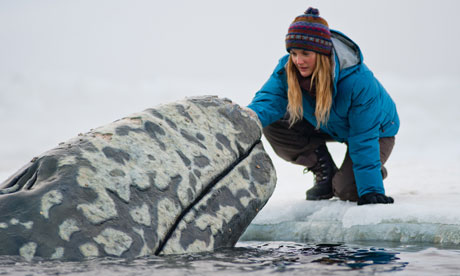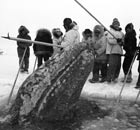Drew Barrymore saves the whales and melts cold war ice in Big Miracle
Hollywood fictionalises the story of Cindy Lowry, who persuaded the Americans and Russians to free trapped whales in Alaska

Drew Barrymore in a scene from Big Miracle, a film about the rescue of a family of gray whales trapped by rapidly forming ice in the Arctic Circle. Photograph: Darren Michaels/AP/Universal Pictures
October 1988, Alaska: the end of the cold war. Ronald Reagan was US president, communism in eastern Europe was cracking and the ice had come in early. Cindy Lowry, a Greenpeace representative in Anchorage, read in a local paper that three young gray whales were stranded near America's northernmost city, Barrow. It was the start of a story that 24 years later has Lowry portrayed by Drew Barrymore in Big Miracle, a Hollywood film out on Friday.
Lowry was with Donny, her doberman, working on oil companies and overfishing. Then the phone rang. Could Greenpeace lend an icebreaker to get the whales out? Greenpeace never had an icebreaker. A biologist called to say the whales had little time left.
Lowry hit the phones. First she called the governer's office to ask where the coastguard icebreaker was. No interest. Then she tried a senator, the state fisheries department and Noaa, the National Oceanic and Atmospheric Administration. She tried whalers and oil companies, the coastguard itself, then got through to General John Schaeffer, adjutant general of the Alaska national guard. A media friend had told her the US and Russia had an agreement to help each other if their ships were in trouble. So she phoned Moscow.
Her telephone manner must have been extraordinary. By the end of the day, Lowry had the offer of an oil company barge, the US under-secretary for oceans had called from Washington pledging help, and the Russians were said to be interested. "It was getting pretty crazy. Everyone was phoning me. But it didn't seem that strange at the time. I was just so focused on the mission," she says.
 Rescuers look on as a gray whale surfaces in a breathing hole off Point Barrow, Alaska, in 1988. Photograph: Bill Roth/Getty Images Thirty-six hours later she was on her way to Barrow. "To start with there was just me, a biologist from Noaa, and the oil companies," she says.
Rescuers look on as a gray whale surfaces in a breathing hole off Point Barrow, Alaska, in 1988. Photograph: Bill Roth/Getty Images Thirty-six hours later she was on her way to Barrow. "To start with there was just me, a biologist from Noaa, and the oil companies," she says.
An NBC crew with a helicopter took her to see the whales, about 12 miles away . " They were trapped in two tiny holes cut in the ice and there was only just room for two of them to breathe. We could tell right away that the smaller one wasn't breathing that well.
"The oil companies wanted to get barges to them, the Iñupiats [native Alaskans] wanted to chainsaw the holes. Every two or three days there was a new crisis. It was -20C and getting colder."
The drama was told around the world as the nations worked together, with the usual hostilities between corporations and environmentalists, media and military suspended.
By the end of week one, the ice was getting busy. The US air force diverted its largest cargo plane from Japan to bring in an 11-tonne amphibious icebreaking tractor from Prudhoe Bay, then came not one, but two Soviet ships, the icebreaker Admiral Makarov and a cargo ship, the Arsenev. The Iñupiat called the little whale Bone because its head had been rubbed raw as it tried to push through the ice.
The best hope lay with the Soviets clearing a channel, but the danger was that the ship would kill the whales. "It was one or two in the morning. We felt they were [getting] too close. The whales were getting frisky. I think they could start sensing open water, and they started swimming really fast from hole to hole," Lowry says.
The rescuers had set up a light for the Admiral Makarov to see the hole. "I thought I was going to say goodbye to the whales. I sat down by the hole on my own and one of the whales came up and spouted water. The freezing whale breath darkened my anorak.
"It was pretty surreal. You're 12 miles out and a Soviet icebreaker is [heading towards you] like a skyscraper. I kneeled down on the ice and the whale rested its head just inches away from me and we had this most amazing eye contact."
It was pure Hollywood, but the film has developed the story. It now runs: "The incredible true story that united the world. A small town news reporter and an animal-loving volunteer, Drew Barrymore, are joined by rival world superpowers to save a family of majestic gray whales trapped by rapidly forming ice in the Arctic Circle."
In the movie Donny the doberman doesn't get a part, the whales are puppets and the love interest is strictly between humans. "There was no romance on the ice. It was a romance with me and the whale," says Lowry, morphed into Barrymore's "animal lover" Rachel Kramer.
Lowry, who today has her own organisation, Oceans Public Trust Initiative, follows other US environmental women activists including Karen Silkwood, Erin Brockovich and Dian Fossey in having her story told by Hollywood.
She is not over-worried about the fictionalising. "It's not a documentary. It's pretty much the same. I just hope the movie will make people aware. I hope in my lifetime that I will see the end of whaling. The reality is that the oceans which we return whales into these days are in much worse shape now than they were just 20 years ago. The reality is that the oceans today are far more polluted than they were."
The real life story had a bittersweet ending. Three days after the whales were released a friend rang Lowry to say the gray whales were in Prince William Sound, heading south. But real life is not Hollywood: "The good news was two had survived. But Bone, the little whale, hadn't made it."www.realty-dejavu.com
Lowry was with Donny, her doberman, working on oil companies and overfishing. Then the phone rang. Could Greenpeace lend an icebreaker to get the whales out? Greenpeace never had an icebreaker. A biologist called to say the whales had little time left.
Lowry hit the phones. First she called the governer's office to ask where the coastguard icebreaker was. No interest. Then she tried a senator, the state fisheries department and Noaa, the National Oceanic and Atmospheric Administration. She tried whalers and oil companies, the coastguard itself, then got through to General John Schaeffer, adjutant general of the Alaska national guard. A media friend had told her the US and Russia had an agreement to help each other if their ships were in trouble. So she phoned Moscow.
Her telephone manner must have been extraordinary. By the end of the day, Lowry had the offer of an oil company barge, the US under-secretary for oceans had called from Washington pledging help, and the Russians were said to be interested. "It was getting pretty crazy. Everyone was phoning me. But it didn't seem that strange at the time. I was just so focused on the mission," she says.
 Rescuers look on as a gray whale surfaces in a breathing hole off Point Barrow, Alaska, in 1988. Photograph: Bill Roth/Getty Images Thirty-six hours later she was on her way to Barrow. "To start with there was just me, a biologist from Noaa, and the oil companies," she says.
Rescuers look on as a gray whale surfaces in a breathing hole off Point Barrow, Alaska, in 1988. Photograph: Bill Roth/Getty Images Thirty-six hours later she was on her way to Barrow. "To start with there was just me, a biologist from Noaa, and the oil companies," she says.An NBC crew with a helicopter took her to see the whales, about 12 miles away . " They were trapped in two tiny holes cut in the ice and there was only just room for two of them to breathe. We could tell right away that the smaller one wasn't breathing that well.
"The oil companies wanted to get barges to them, the Iñupiats [native Alaskans] wanted to chainsaw the holes. Every two or three days there was a new crisis. It was -20C and getting colder."
The drama was told around the world as the nations worked together, with the usual hostilities between corporations and environmentalists, media and military suspended.
By the end of week one, the ice was getting busy. The US air force diverted its largest cargo plane from Japan to bring in an 11-tonne amphibious icebreaking tractor from Prudhoe Bay, then came not one, but two Soviet ships, the icebreaker Admiral Makarov and a cargo ship, the Arsenev. The Iñupiat called the little whale Bone because its head had been rubbed raw as it tried to push through the ice.
The best hope lay with the Soviets clearing a channel, but the danger was that the ship would kill the whales. "It was one or two in the morning. We felt they were [getting] too close. The whales were getting frisky. I think they could start sensing open water, and they started swimming really fast from hole to hole," Lowry says.
The rescuers had set up a light for the Admiral Makarov to see the hole. "I thought I was going to say goodbye to the whales. I sat down by the hole on my own and one of the whales came up and spouted water. The freezing whale breath darkened my anorak.
"It was pretty surreal. You're 12 miles out and a Soviet icebreaker is [heading towards you] like a skyscraper. I kneeled down on the ice and the whale rested its head just inches away from me and we had this most amazing eye contact."
It was pure Hollywood, but the film has developed the story. It now runs: "The incredible true story that united the world. A small town news reporter and an animal-loving volunteer, Drew Barrymore, are joined by rival world superpowers to save a family of majestic gray whales trapped by rapidly forming ice in the Arctic Circle."
In the movie Donny the doberman doesn't get a part, the whales are puppets and the love interest is strictly between humans. "There was no romance on the ice. It was a romance with me and the whale," says Lowry, morphed into Barrymore's "animal lover" Rachel Kramer.
Lowry, who today has her own organisation, Oceans Public Trust Initiative, follows other US environmental women activists including Karen Silkwood, Erin Brockovich and Dian Fossey in having her story told by Hollywood.
She is not over-worried about the fictionalising. "It's not a documentary. It's pretty much the same. I just hope the movie will make people aware. I hope in my lifetime that I will see the end of whaling. The reality is that the oceans which we return whales into these days are in much worse shape now than they were just 20 years ago. The reality is that the oceans today are far more polluted than they were."
The real life story had a bittersweet ending. Three days after the whales were released a friend rang Lowry to say the gray whales were in Prince William Sound, heading south. But real life is not Hollywood: "The good news was two had survived. But Bone, the little whale, hadn't made it."www.realty-dejavu.com

 photo
Tia Butt
photo
Tia Butt